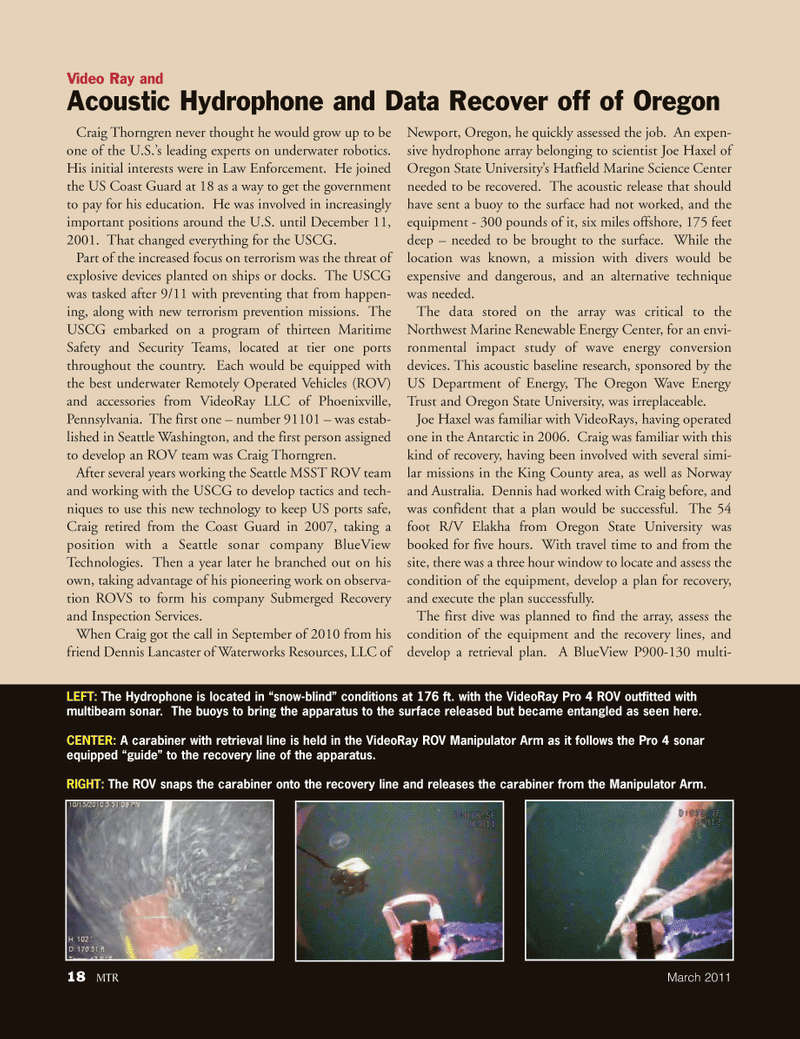
Page 18: of Marine Technology Magazine (March 2011)
Subsea Vehicles: AUV, ROV, UUV Annual
Read this page in Pdf, Flash or Html5 edition of March 2011 Marine Technology Magazine
18 MTR March 2011
Craig Thorngren never thought he would grow up to be one of the U.S.’s leading experts on underwater robotics.
His initial interests were in Law Enforcement. He joined the US Coast Guard at 18 as a way to get the government to pay for his education. He was involved in increasingly important positions around the U.S. until December 11, 2001. That changed everything for the USCG.
Part of the increased focus on terrorism was the threat of explosive devices planted on ships or docks. The USCG was tasked after 9/11 with preventing that from happen- ing, along with new terrorism prevention missions. The
USCG embarked on a program of thirteen Maritime
Safety and Security Teams, located at tier one ports throughout the country. Each would be equipped with the best underwater Remotely Operated Vehicles (ROV) and accessories from VideoRay LLC of Phoenixville,
Pennsylvania. The first one – number 91101 – was estab- lished in Seattle Washington, and the first person assigned to develop an ROV team was Craig Thorngren.
After several years working the Seattle MSST ROV team and working with the USCG to develop tactics and tech- niques to use this new technology to keep US ports safe,
Craig retired from the Coast Guard in 2007, taking a position with a Seattle sonar company BlueView
Technologies. Then a year later he branched out on his own, taking advantage of his pioneering work on observa- tion ROVS to form his company Submerged Recovery and Inspection Services.
When Craig got the call in September of 2010 from his friend Dennis Lancaster of Waterworks Resources, LLC of
Newport, Oregon, he quickly assessed the job. An expen- sive hydrophone array belonging to scientist Joe Haxel of
Oregon State University’s Hatfield Marine Science Center needed to be recovered. The acoustic release that should have sent a buoy to the surface had not worked, and the equipment - 300 pounds of it, six miles offshore, 175 feet deep – needed to be brought to the surface. While the location was known, a mission with divers would be expensive and dangerous, and an alternative technique was needed.
The data stored on the array was critical to the
Northwest Marine Renewable Energy Center, for an envi- ronmental impact study of wave energy conversion devices. This acoustic baseline research, sponsored by the
US Department of Energy, The Oregon Wave Energy
Trust and Oregon State University, was irreplaceable.
Joe Haxel was familiar with VideoRays, having operated one in the Antarctic in 2006. Craig was familiar with this kind of recovery, having been involved with several simi- lar missions in the King County area, as well as Norway and Australia. Dennis had worked with Craig before, and was confident that a plan would be successful. The 54 foot R/V Elakha from Oregon State University was booked for five hours. With travel time to and from the site, there was a three hour window to locate and assess the condition of the equipment, develop a plan for recovery, and execute the plan successfully.
The first dive was planned to find the array, assess the condition of the equipment and the recovery lines, and develop a retrieval plan. A BlueView P900-130 multi-
Video Ray and
Acoustic Hydrophone and Data Recover off of Oregon
LEFT: The Hydrophone is located in “snow-blind” conditions at 176 ft. with the VideoRay Pro 4 ROV outfitted with multibeam sonar. The buoys to bring the apparatus to the surface released but became entangled as seen here.
CENTER: A carabiner with retrieval line is held in the VideoRay ROV Manipulator Arm as it follows the Pro 4 sonar equipped “guide” to the recovery line of the apparatus.
RIGHT: The ROV snaps the carabiner onto the recovery line and releases the carabiner from the Manipulator Arm.

 17
17

 19
19
